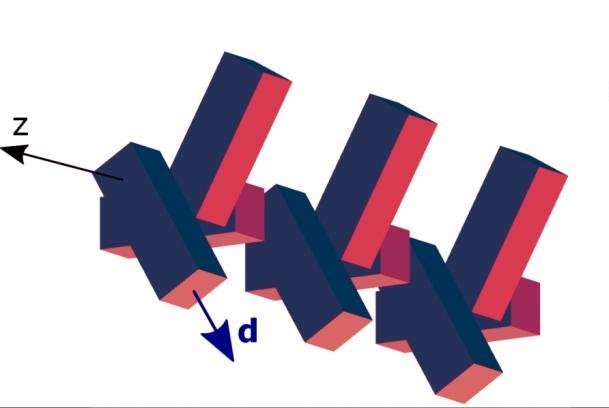A diagram reveals the helix-like chiral superstructure of a newly synthesized supercrystal. Photo by ITMO University
ST. PETERSBURG, Russia, May 24 (UPI) -- Researchers in Russia report they have built a supercrystal with a unique helix staircase-like superstructure capable of separating organic molecules. Scientists say the new superscrystal can facilitate the synthesis of drugs.
Supercrystals are crystals with enhanced crystalline structures -- in this case a superstructure of rod-shaped quantum dots. What makes these tiny semiconducting dots unique is the property of chirality.
Chirality is a property of asymmetry. An object is chiral if it can't be superimposed on its mirror image -- like a pair of human hands. In this instance, a pair of quantum dot staircases -- one twisting to the left, the other twisting to the right -- give the superstructure its chirality.
A pair of chiral mirror images or objects are called enantiomers. The biological world is full of enantiomers. Nearly all organic molecules, like proteins or nucleic acids, feature chiral components.
Chirality in the human body means many drugs can trigger two simultaneous and potentially contradictory biological actions. One action might be therapeutic, but the other might be toxic. For this reason, enantiomers must be separated during drug synthesis.
"As with any chiral nanostructure, the range of applications of our supercrystals is huge," Ivan Rukhlenko, a researcher at ITMO University in St. Petersburg, said in a news release. "For example, we can use them in pharmacology to identify chiral drug molecules."
"Gathering in spirals around them, quantum dots can exhibit collective properties that enhance molecule absorptivity by hundreds of times," Rukhlenko explained. "Thus, the molecules can be detected within solution with much more accuracy."
The new supercrystal could also have a variety of applications in optical fields. Because its quantum dot superstructure concentrates optical activity along its longitudinal axis, the supercrystal could prove useful in technologies requiring light polarization.
Researchers say the new supercrystal is also highly adaptable.
"Knowing the output parameters of optical properties, we can model a supercrystal to solve a specific problem," ITMO scientist Anvar Baimuratov said. "Conversely, having data on the supercrystal structure, we can accurately predict its optical activity."
Baimuratov is the lead author of a new paper on the discovery, published this week in the journal Scientific Reports.















